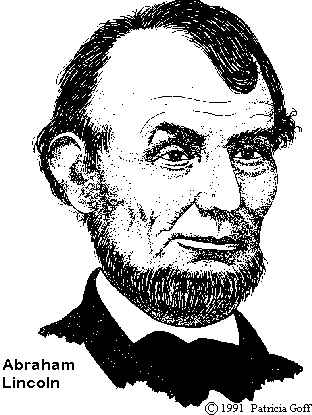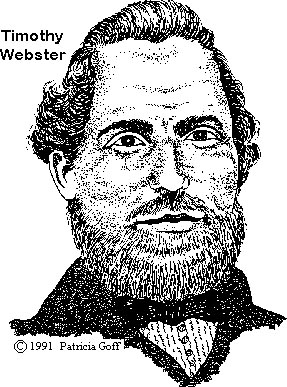A COLLECTION OF WRITINGS CONCERNING ALLAN PINKERTON AND THE LARCH FARM
Compiled
by Patricia Dissmeyer Goff, P. O. Box 1482, Elgin, IL 60121-1482
(This material
is available to be uploaded, copied, printed, and shared so long as the compiler's
name and address stays with this material)
PREFACE
Except for the first chapter, this book is a compilation of
writings of other people concerning Allan Pinkerton. The report I wrote when I was
seventeen is the first chapter because it is a simple, general view of Pinkerton
and his life. It gives the reader an idea of who Allan Pinkerton was. There are
many books written about Allan Pinkerton, but I have yet to find one mainly concerning
The Larch Farm.
The manuscript written by Russell Palmer is extremely well
written and interesting. I obtained this copy from the Iroquois County Genealogical
Society in Watseka, Illinois. I believe there is another copy in the Newberry Library
in Chicago. There are probably other copies in some private homes. This manuscript
is important enough that it deserves to be published and distributed so that many
people have access to it.
I have always found Allan Pinkerton a fascinating
character, so I have taken it upon myself to publish the information I have concerning
him. Another reason for my interest is that my home town is Onarga, Illinois, where
Pinkerton's summer home, "The Larch Farm," is located. Timothy Webster's
grave is also located in Onarga. My grandmother was very interested in local history,
and this interest was naturally instilled in me.
I created the artwork in
this book either freehand or using a computer Paint program.
I hope this
book is enjoyed by all who read it.
ALLAN PINKERTON and the LARCH FARM
by Patty Dissmeyer, May 27, 1966
for
Mr. Barnes, American History Class, Larkin High School, Elgin, Ill.
The Allan
Pinkerton house has been standing in its grove of larch trees just outside of Onarga
for more than 90 years. During that time it has given rise to many conjectures and
legends. These legends were caused by the career of the man who once owned the house,
for Allan Pinkerton is the most well known private detective in the history of the
United States.
In order to understand the significance of this famous old
home, let us probe into the exciting life of Allan Pinkerton.
PINKERTON'S
EARLY LIFE
Allan Pinkerton was born in Gorbals, Glasgow, Scotland, in 1819,
the son of a Glasgow police sergeant. Young Pinkerton, as an apprentice cooper,
became involved in the dangerous Chartist Labor movement and fled from Scotland at
the age of 23, only one day after his marriage, and settled in the city of Chicago.
Pinkerton
worked for a year in Chicago as a cooper and then moved to the Scotch community of
Dundee on the Fox River. In 1846, he was made Deputy Sheriff of Kane County after
he discovered and helped round up a gang of counterfeiters.
Pinkerton was
an ardent abolitionist, and served as "foreman" of the Underground Railway,
using his cooper's shop as a "station" of the railway.
In 1850 he
was chosen by the Chicago Police Force to be Chicago's first detective. Later he
organized a private detective agency, the Pinkerton Detective Agency, America's first
such organization, and helped in solving several express robberies.
PINKERTON AND ABRAHAM LINCOLN 
In
1861, Pinkerton was asked by officials of the Philadelphia, Wilmington, and Baltimore
railroad to track down rumors that secessionists were
planning to blow up the
steamers that ferried the trains across the Susquehanna River. Disguising himself
as one John H. Hutchinson and adopting a Southern accent, he established himself
as a nightly figure at one of the secessionist's favorite hangouts. He soon learned
that more was at stake than a few railroad cars. One secessionist, who had too much
to drink, stated that Lincoln would be assassinated as he passed through Baltimore
on Saturday, February 23. Pinkerton foiled this plan by having Lincoln take a train
leaving on the 19th of February and keeping the change in schedule in complete secrecy.
On March 4, 1861, Lincoln delivered his famous inaugural speech in front of the
unfinished capitol, thanks to the tactics of Allan Pinkerton.
 TIMOTHY WEBSTER
TIMOTHY WEBSTER
Timothy Webster, a member of Allan Pinkerton's staff of secret
operators, was first selected to guard Lincoln on his journey to Washington for his
inauguration.
After receiving evidence that an organization had been formed
whose purpose was to plot the assassination of the President, Pinkerton sent Timothy
Webster to become a member of the group and report to Pinkerton of their plans and
activities. Because of this, the group was prevented from accomplishing its purpose.
Pinkerton himself, under the nom-de-plume of Major E. J. Allen,
obtained considerable information by traveling south.
Acting under orders
from Pinkerton, Webster went to live in Baltimore where he posed as a Southern gentleman
and continued to report to Pinkerton.
In 1862, Webster was gathering much
information in Richmond, when he was stricken with a severe case of Rheumatism.
Greatly concerned for Webster's health and safety, Pinkerton sent two men to locate
him. They were caught and forced to reveal secret information to the confederates.
Apparently, the information they gave incriminated Webster, because he was arrested
soon thereafter and hung as a spy.
Timothy Webster's body now lies in the
Cemetery on the northern edge of Onarga, Illinois. The marker on his grave reads:
SACRED TO THE MEMORY OF T I M O T H Y W E B S T E R who was Executed as
a Spy by the
REBELS, IN RICHMOND VIRGINIA April 29, 1862 AFTER GALLANT SERVICE
IN THE
WAR OF THE REBELLION HE SEALED HIS FIDELITY AND DEVOTION TO HIS COUNTRY
WITH HIS BLOOD
[Note: In 1967 this grave marker was almost illegible; at
the present time, it cannot be read at all.]
THE LARCH FARM
In 1864,
Pinkerton purchased a tract of land about one mile north of Onarga, Illinois. In
1873 Pinkerton, determined to carry out an idea which had long occupied his mind,
at once began active preparations and after seven years of hard labor and lavish
expenses, the "Larch Farm" became the model of Iroquois County, Illinois.
DESCRIPTION
OF THE ORIGINAL LARCH FARM
The original square building had a verandah
on all four sides. Directly above the small room in the center of the attic is a
cupola extending six feet vertically from the roof line, which had a short flag pole
on top.
The original structure had six rooms, three on each side of a wide
hall that ran the entire length of the building. The sides of this hall above the
wainscoting were adorned with paintings of battle scenes and officers of the Civil
War, the work having been done by F. W. Seyer in 1882. The rooms have not changed
except for the openings into the rooms that have since been added.
Pinkerton
created the Larch Farm as a replica of a gentleman's estate he had known when a boy
in Scotland. Larch trees were set in orderly rows along the drives of the estate.
Along these drives were placed thousands of flowers in beds that were always neat
and orderly. Guards were stationed at the gates and visitors who drove their horses
along the drive faster than a walk were fined five dollars for raising dust that
would settle on the flowers.
The drive circled the house and led to the outbuildings.
These included the Snuggery, mild house, root cellar, Big Jumbo, and a small barn.
Big Jumbo was a very large barn that housed his horses, of which the foundation
only remains. The Snuggery was the wine house and built partially underground, the
underground part now being filled in. The sides of the ceiling of the snuggery
were covered with portraits of heroic Scots attired in kilts. These oils are still
to be seen, though dimmed by age. The fish pond and swimming pool, which were located
northeast of the main buildings, have been filled in. Originally, there were life
sized statues of Negroes, Indians, and animals, made or iron, along the driveways
and at the two entrance gates to the grounds. But they, too, have disappeared.
PRESENT
CONDITION
Little remains of the grandeur it had when originally built.
The outbuildings, as well as the house, show signs of decay, and little remains
now to recall the former glories of the Larch Farm. Almost all of the thousands
of Larch trees that once stood magnificently on those grounds have been cut down.
A
few of the Onarga townsfolk have memories of their experiences with the Larch Farm:
Says one Onarga Resident: [Charles H. Warnock, 301 East Lincoln, Onarga, IL.]
"Closing
my eyes, I can still dimly see the beautiful Larch Farm of the early 1890's. One
of the "treats" on Sunday afternoons was to hitch up the horse and drive
through the Larch Farm. From the West entrance, near the house, the road went east,
across the I. C. Railroad and then south, coming out near the cemetery. As I recall
it, the buildings, visitor's house, two big barns, and the Snuggery, were in good
repair and colored guards in uniforms were stationed on this driveway.
"Later,
probably as a curious grade-school kid, I can remember inspecting the insides of
these buildings. We were thrilled by the paintings in the hallway of the house and
were told that Mr. Pinkerton imported a painter from Scotland to do them on canvass-lined
walls. They were mostly battle scenes and groups of Civil War officers, men and
prominent citizens. Years later I found most of these paintings gone, a few evidently
torn off the walls, rolled up, and stuffed into a barrel in the Snuggery. What a
shame they were not properly preserved!
"It was my impression that the
Larch Farm was primarily used by Mr. Pinkerton to hide Civil War spies and as a recreation
center for them. We also understood that the place was used at times for an Underground
Railroad to assist escaping Negroes. [Note: There have been many rumors that the
Larch Farm was an Underground Railroad station, but obviously it could not have been
this house, as it was not built until 1873. (Illinois State Historical Library)]
Today the place is a dismal wreck; a sad ending to am important chapter
in history." Allan Pinkerton died on July 1, 1884. Since his death, the Larch
Farm has gradually declined until it has reached the state it is now in.
Go to Palmer Manuscript
Return to Photo Index
Return to Iroquois County GenWeb Page

 TIMOTHY WEBSTER
TIMOTHY WEBSTER